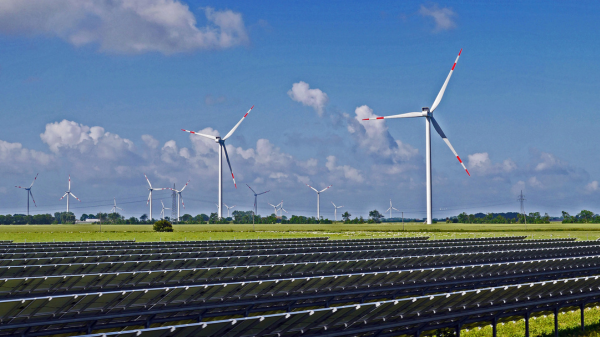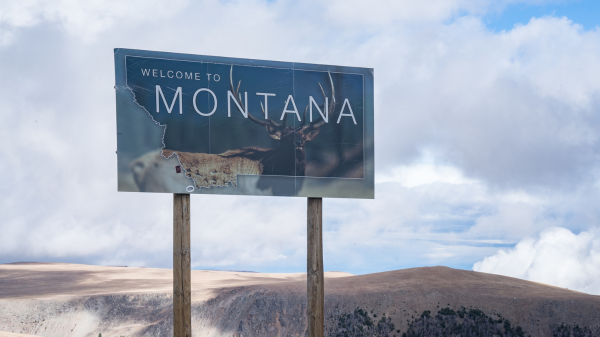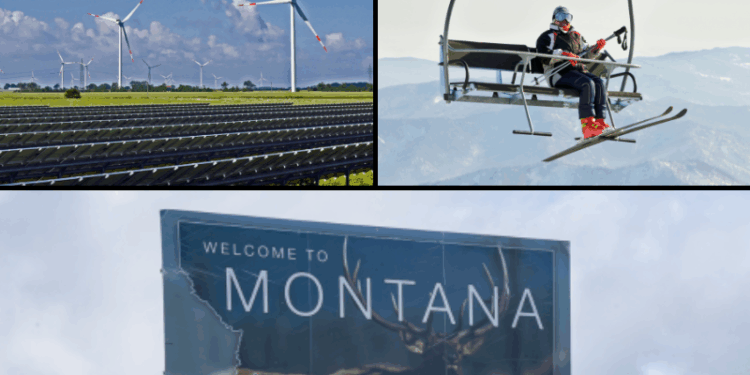IN THIS ISSUE:
- Study: Net Zero Wind and Solar Buildout Needs Huge Amount of Land
- Uncovered Ski Lifts Show Rapid Climate Change in Recent Past
- Climate Lawfare Sidelined in Montana

Study: Net Zero Wind and Solar Buildout Needs Huge Amount of Land
New research published in the journal Nature confirms what The Heartland Institute and our allies in the free-market environmental community have long argued: wind and solar power have low power density and thus impose huge environmental footprints. The new study acknowledges the environmental footprint of wind and solar is even larger than industry promoters have admitted. As a result, to reach net zero with wind and solar as the primary sources of electric power will require the transformation of a large swath of agricultural land and wildlands into industrial power sites.
The report from researchers at the U.S. Department of Energy’s Pacific Northwest National Laboratory in Washington state found a high-renewable scenario will require a lot more land, much of it on or near undeveloped or wild areas, than a plan for less wind and solar incorporation into the grid. They write,
Expanding United States electricity infrastructure to meet growing demand could require extensive power plant development footprints and land use conversion, depending on the mix of generation types chosen. Understanding where future power plant sitings are likely to take place and identifying potential conflicts and land-use tradeoffs will be key to identifying feasible and affordable investments and evaluating regional planning coordination needs. Here we use an integrated modeling framework that combines capacity expansion planning, hourly grid operations, and geospatial techno-economic analysis to develop projections (2025-2050) of power plant sitings in the Western United States (US) . . . for a business-as-usual scenario and a high renewables penetration scenario. We find that 30% more land will be needed in the high renewables scenario as compared to business-as-usual, and that 75% of that development is projected to be located within 10 km of natural areas.
It is important to note that even the “business as usual” capacity expansion scenario assumes wind and solar power will be the dominant new sources generating electric power in the United States.
“Results from the capacity expansion analysis show that approximately 85% of new power capacity deployed in the Western US by 2050, under either a high renewables or business-as-usual scenario, will consist of solar photovoltaics (PV) and onshore wind,” says the study.
This analysis seemingly ignores the fact that the Trump administration is rapidly cancelling wind and solar projects and funding for associated infrastructure and technologies while pushing new nuclear and natural gas and keeping existing coal operational. The researchers’ entire analysis seems to assume the trend that began under Obama and expanded under Biden will continue in the future, regardless of current policies and the preferences of Trump’s successors as president. Presidential administrations after Trump might continue or expand on his efforts rather than going back to the energy policies under the net zero goals of previous democratic administrations.
Those questionable assumptions aside, and after accounting for assumed existing and modeled environmental and development exclusions, the study found under the business-as-usual scenario (which I would consider an exceedingly high, unjustified expansion of wind and solar power) new wind and solar will require more than 23,333 square kilometers (km2) of land, more than 9,010 square miles. And that’s the low-penetration, business-as-usual case. The high wind and solar scenario will require an additional 7,000 km2, or 2,703 square miles of land. And to be clear, this does not include the indirect land footprints of mining for rare earth elements and critical minerals needed for wind and solar, spacing between panels, or the land needed for the expanded transmission grid. In addition, this analysis just covers expansion in the western United States, where sunlight and wind in some areas are more favorable for wind and solar development than elsewhere in the country, where electricity demand is also growing.
The footprint of the anticipated growth in wind and solar facilities alone is greater than the size of New Jersey and close to the size of Connecticut, Delaware, and Rhode Island combined.
Other analyses suggest the land footprint of wind and solar to meet net zero goals is even larger. A June 2025 report from the Center of the American Experiment found the low energy density (the amount of energy produced by volume or mass, in this case land space required to produce a megawatt of power) means that,
wind turbines and solar panels need at least 10 times as much land per unit of power produced as coal- or natural gas-fired power plants. To generate the same amount of electricity as a 1 GW nuclear plant, which occupies approximately 1.3 square miles, one would need between 45 and 75 square miles of solar panels or between 260 and 3,360 square miles of wind turbines. The latter is larger than the combined areas of Delaware and Rhode Island. If the U.S. relied entirely on wind turbines for electricity, it would need about twice the size of the state of California [to generate enough electricity to satisfy American needs].
An earlier analysis produced by The Heartland Institute found replacing the amount of power produced by fossil fuels and nuclear in the United States in 2019 (eight billion MWh each year, not accounting for any growth in demand) “with solar would require completely blanketing 57,048 square miles of land—an area equivalent to the size of the states of New York and Vermont—with 18.8 billion solar panels.” Replacing 2019’s energy produced by fossil fuels and nuclear with wind power “would require 2.12 million turbines on 500,682 square miles of farm, wildlife habitat, and scenic lands. This would require an amount of land as large as the combined total for Arizona, California, Nevada, Oregon, and much of West Virginia.”
A 2023 series of papers from Heartland, Energy at a Glance, also looked at the environmental impacts of the newest generation of the largest, most efficient wind and solar technologies. It found solar power requires three times as much land per megawatt of electricity produced as do coal, natural gas, or nuclear, with panels creating 300 times as much toxic waste per unit of energy produced as nuclear. In addition, “[r]eplacing current electricity generation with wind power may require covering 1/3 of the American land mass with wind turbines, and electrifying all transportation would increase that number to 1/2.”
Of course, the Nature study didn’t address replacing existing demand but instead focused on meeting the expected growth of electricity demand, so the land footprint it describes is on top of any land used to replace existing electricity supply produced by fossil fuels and nuclear facilities that are prematurely shuttered in order to meet net zero goals.
The bottom line is this: wind and solar have low power density, requiring a lot of land to produce less-reliable, expensive power than is delivered efficiently and relatively inexpensively by existing fossil fuel and nuclear plants. In addition, wind and solar don’t work well in all locations and are precluded in others; require constant, expensive, redundant back-up supplies of power to account for fluctuations and intermittency; and use up large amounts of land for new transmission.
With all this in mind, if net zero or even reducing greenhouse gas emissions substantially but short of net zero is no longer government policy, there is no reason to destroy the millions of acres of wildlife habitat, productive farm land, and other valuable land that could be or is being put to other productive uses, by installing massive amounts of industrial wind and solar facilities. In fact, since the best evidence, in the form of hard data, suggests catastrophic climate change is neither in the offing nor likely to occur, the huge expansion of wind and solar that has already been forced onto the grid by politicians boosting the profits of politically connected green energy profiteers was never justified. Instead, it undermined U.S. energy independence and dominance and was a geopolitically and economically costly distraction from the best path to reliable, relatively inexpensive power: expanding the nation’s fleet of fossil fuel and nuclear power plants.
China, our main economic and geopolitical competitor, clearly understood this and has been expanding fossil fuel use for power while encouraging the United States and Europe to pursue the green energy transition that has led us down the path of carbon dioxide-constrained deindustrialization.
Sources: Nature; The Heartland Institute; Energy at a Glance: Solar Power and the Environment; Energy at a Glance: Wind Power and the Environment

Uncovered Ski Lifts Show Rapid Climate Change in Recent Past
A news reports states glacier melt is uncovering a ski lift in Dachstein Glacier, Austria. The story warns that rapid melting there is a sign of human-caused climate change, showing no curiosity about how a development so recent as a ski lift could have been covered in ice and forgotten already.
The details are interesting because they show climate conditions often change rapidly and recent changes aren’t that unusual.
A summer heat wave uncovered “the Hunerkogel, a ski lift built in 1969 and buried under ice in the late 1970s,” writes The Cool Down. “Because it is melting faster than new snowfall can replace it, the Dachstein Glacier continues to shrink.”
Dissecting that description of the chain of events, the glacier was smaller in the recent past, allowing the erection of a large ski run that its developers undoubtedly believed would be a long-term moneymaking venture. Then, in less than a decade, their investment was lost as the glacier added so much snow and ice that the new ski lift was buried. It is of interest to note the glacier advanced enough during the 1970s to cover the lift for decades, occurring at a time when the Earth was modestly cooling and many scientists were warning it was a sign of a coming ice age—while CO2 emissions were increasing in the atmosphere as they had been steadily doing since the late 1800s and especially during the post-World War II industrial development binge. The ski lift was covered in snow and ice and was forgotten in much less time, a decade, than it has taken for the ice to retreat and reveal it to the world once again, about 45 years.
Glaciers are not permanent. They wax and wane, and typically time periods when they are expanding are worse for human societies because they coincide with global temperature declines and associated crop failures and disease outbreaks.
So now the glacier is back to about where it was when a ski lift was constructed just 56 short years ago. (In geologic time, that’s not even a blip.) The cause might be climate change, but if so, the evidence suggests such changes are consistent with natural trends and not historically unusual.
Climate Change Weekly has documented similar findings in the recent past: Viking “highways,” evidence of ancient penguin colonies, villages, bodies, and more recently World War Two aircraft have all been uncovered after being trapped for decades, centuries, or millennia under ice and snow. That proves, beyond doubt, that temperatures in the past were warmer or as warm as at present and ice levels were lower across much of the globe than highs reached in the late 1970s and early 1980s when direct tracking and consistent recordkeeping first took hold.
Source: Yahoo News/The Cool Down

Climate Lawfare Sidelined in Montana
Another climate change lawfare case was dismissed in another court last week. On October 15, U.S. District Judge Dana Christensen dismissed a lawsuit by the climate lawfare activist groups Our Children’s Trust and Public Justice on behalf of 22 “youths.”
The plaintiffs sought to block three executive orders filed by President Donald Trump, which they claimed would violate their rights to a clean and healthy environment by encouraging and allowing more fossil fuel development and use.
In his 31-page decision, Christensen ruled the plaintiffs in Lighthiser v. Trump lacked a legal basis to bring the suit, because the harms they cited weren’t open to judicial amelioration under law.
“Plaintiffs are effectively asking that this court order the United States to return to the environmental policy of the previous administration,” Christensen stated, concluding it would require the court to monitor and micromanage on an ongoing basis “an untold number” of federal agencies and actions, a power not given to the court in law and unworkable in practice.
“This is, quite simply, an unworkable request for which plaintiffs provide no precedent,” Christensen ruled, noting the recourse the plaintiffs sought could only be found in legislative action.
In his written decision, Christensen noted the case before him was similar to Juliana v. United States, a landmark case filed by many of the same plaintiffs in 2015, which was ultimately dismissed by the Ninth Circuit Court of Appeals on the grounds that there is “no constitutional right to a pollution-free environment” and that the courts were not the proper venue for policy changes to establish such a right.
Sources: Newsmax; The New York Times

















